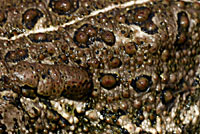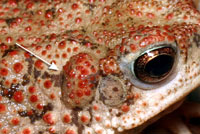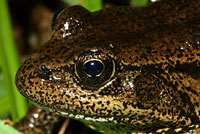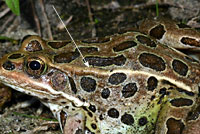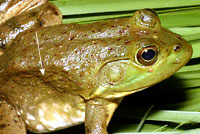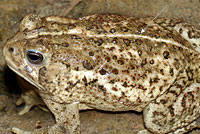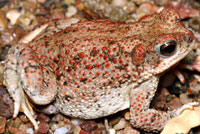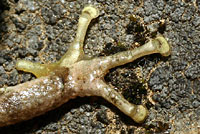Identifying California Frogs and Toads

California Frogs and Toads: |

This is not a scientific key to identifying frogs and toads found in California. It is meant to be used as a basic tool for the novice who wants identify an animal primarily by appearance, location, or sound. There are three ways to use this identification section. |
|||||||||||||||||
1. First, it might be helpful if you look first at the California Frogs and Toads Photo Index page with one general picture of all types of frogs and toads found in the state. You can access more detailed information and more pictures from the index. It may also help to look at the Range Maps for all California Frogs and Toads, to see which ones are found in your area, and proceed from there. If you'd like to identify a frog or toad from a call that you have heard, go to the Frog and Toad Calls Page where you can listen to calls of most frogs and toads in California, read a brief description of the call, and get information about when and where each species calls. |
|||||||||||||||||
| 2. Try this IDENTIFICATION KEY which makes note of particular details and then uses a process of elimination to eventually get to the animal you want to identify. If it does not work for you, try using part 3 below. |
|||||||||||||||||
| 3. Identification using location and some simple visual observations The different species of California Frogs and Toads have been separated below into a few basic groups in order to help you identify them. (Tadpoles and Metamorphs are beyond the scope of this identification aid.) Find the group which most resembles the animal you want to identify, and look at the thumbnail images (click on them to see a larger version) then read the brief description until you find an animal similar to the frog or toad you are trying to identify. Click on the link for further details about the group. If you already know the type of frog and want to determine the species within that type, jump down to some more specific information using the links in the table below. Be aware that many species of frogs and toads look alike, and that there are other factors that can help you identify them besides appearance, such as geographical location, behavior, and habitat. Also, some frogs and toads have several color and / or pattern variations and we do not show all of them on this page. Some of these variations will be shown on the main page which you can get to by clicking on a name link here. Juveniles often do not look exactly like adults, so if you are trying to identify a juvenile, look closely at the body shape, eyes, toes, and other details, and try to find a picture of an adult with a similar appearance, but not necessarily the exact same color or pattern. |
|||||||||||||||||
If you don't find it here, it's possible that the frog or toad you found is a non-native or introduced animal, such as a released or escaped pet, especially if it is found in or near an inhabited area. It is also possible that you did not get a good enough look at the animal to identify it. Currently there are only a few known widespread introduced frogs and toads in California, but that can change. With many types of frogs and toads common in the pet trade, some of them occasionally escape or are released illegally by irresponsible owners. If you cannot find a frog or toad here, you can also look at our page of Escaped Pets which lists some common pet herps which have been reported to me. If you have any problems using these keys, or suggestions on how to improve them, please send me your feedback. |
|||||||||||||||||
|
|||||||||||||||||
Some Basic Frog Characteristics To help you determine if you have a frog, a treefrog, a toad, or a spadefoot, look at the following details. Later these may also help to determine the species. These are general traits, and there will be some variations; some frogs have slightly bumpy skin, etc. Also note the body shape, color, and the animal's habitat and behavior. |
|||||||||||||||||
| Skin: Smooth, or rough and warty |
|||||||||||||||||
| Rough skin: Toads | Smooth skin: Frogs | ||||||||||||||||
| Parotoid glands; Raised bumpy glands behind the eyes. (Don't confuse parotoids with the tympanum, or eardrum on a frog or toad which is behind the eye, but is not raised up.) |
|||||||||||||||||
| Enlarged Parotoid Glands: Toads | No Glands: Frogs | ||||||||||||||||
| Pupils: Horizontal or vertical. |
|||||||||||||||||
| Horizontal Pupils: Most California Frogs and Toads |
Vertical Pupils: Spadefoots, Tailed Frog |
||||||||||||||||
| Dorsolateral Folds: Ridges on the upper sides of the body |
|||||||||||||||||
| Dorsolateral Folds: Several California Frogs |
No Dorsolateral Folds: Toads, some Frogs |
||||||||||||||||
| Dorsal Stripe: Stripe down the middle of the back. |
|||||||||||||||||
| Striped Back: Some kinds of Toads |
No Stripe: Some Toads, Frogs | ||||||||||||||||
| Toe Tips: Enlarged or not enlarged |
|||||||||||||||||
| Enlarged Toe Tips: Treefrogs |
Straight Toe Tips: Other Frogs and Toads |
||||||||||||||||
| Eye: With a dark patch of color or stripe through the eye, or without. |
|||||||||||||||||
| Dark stripe through eye: some Frogs |
No dark stripe through eye: Toads, some Frogs |
||||||||||||||||
| Spade: A hard black growth on the bottoms of the back feet. |
 |
||||||||||||||||
| Large black spade on bottom of rear feet: Spadefoots |
|||||||||||||||||
| Toads |
|||||||||||||||||
Toads are a type of frog. They can be distinguished from frogs by their rough, warty skin, fat, chunky body, short legs, and large parotoid glands found behind the eyes on the head. These glands vary in shape and size and can help you with species identification. Toads move more by walking than by hopping long distances, which will help differentiate them from frogs. They can be distinguished from Spadefoots by their horizontal pupils and rougher skin. Toads are often seen in yards at night, or day, especially in wet gardens, near sprinklers, near irrigated agricultural areas, on roads at night, especially rainy nights, and around the edges of breeding ponds, lakes, rivers, and creeks, especially after transforming from tadpoles when hundreds or thousands of tiny toadlets can be seen. If the animal you want to identify resembles one of the toads shown below, go here to continue your search to determine which species of toad it is. |
|||||||||||||||||
 |
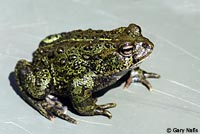 |
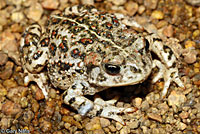 |
|||||||||||||||
| Sonoran Desert Toad Incilius alvarius |
Boreal Toad Anaxyrus boreas boreas |
California Toad Anaxyrus boreas halophilus |
|||||||||||||||
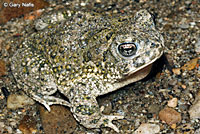 |
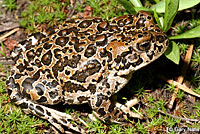 |
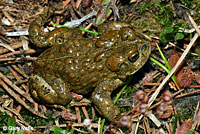 |
|||||||||||||||
| Arroyo Toad Anaxyrus californicus |
Yosemite Toad (Female) Anaxyrus canorus |
Yosemite Toad (Male) Anaxyrus canorus |
|||||||||||||||
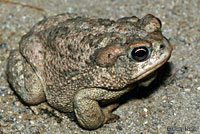 |
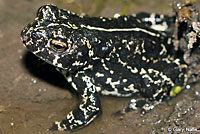 |
 |
|||||||||||||||
| Great Plains Toad Anaxyrus cognatus |
Black Toad Anaxyrus exsul |
Arizona Toad Anaxyrus microscaphus |
|||||||||||||||
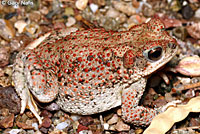 |
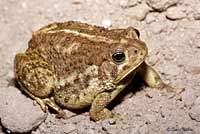 |
||||||||||||||||
| Red-spotted Toad Anaxyrus punctatus |
Rocky Mountain Toad Anaxyrus woodhousii woodhousii |
||||||||||||||||
Frogs |
|||||||||||||||||
| Treefrogs (aka Chorus Frogs) |
|||||||||||||||||
| If you find a frog in California clinging to branches or other vegetation, or rocks in a creek, then it is almost certainly a Treefrog. Treefrogs in California are small, up to about 2 inches long. If you look closely you can see that the tips of their toes are enlarged into little suction cups. They vary widely in coloration, so use other details to identify them. Telling the two types of treefrogs apart should be easy - the California Treefrog only occurs in southern California, has bumpy skin, is usually found along rocky creeks, and does not have a dark stripe through the eye, while the Pacific Treefrog has a dark eye stripe and smooth skin. Also, the California Treefrog will not be bright green, and typically matches the color of rocks in its habitat. The Baja Caifornia Treefrog, the Northern Pacific Treefrog, and the Sierran Treefrog all used to be considered the same frog: the Pacific Treefrog, but now they are considered to be three species. Together, they occur throughout almost the entire state, and are probably the most commonly seen frogs in the California, and are certainly the most commonly heard. They all look and sound the same, so you need to look at a range map to determine which species you are looking at. Juvenile Red-legged Frogs and Yellow-legged Frogs might be confused for these Treefrogs, as they occur in the same areas, but they will not have the enlarged toe pads. If your frog is a treefrog, click on the name links below for further pictures and information to help identify which species. |
|||||||||||||||||
 |
 |
 |
|||||||||||||||
| Baja California Treefrog - Pseudacris hypochondriaca hypochondriaca (two basic color variations) |
Dark stripe through eye | ||||||||||||||||
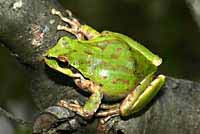 |
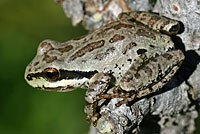 |
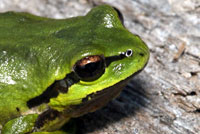 |
|||||||||||||||
| Northern Pacific Treefrog - Pseudacris regilla (two basic color variations) |
Dark stripe through eye | ||||||||||||||||
 |
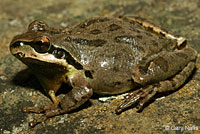 |
 |
|||||||||||||||
| Sierran Treefrog - Pseudacris sierra (two basic color variations) |
Dark stripe through eye | ||||||||||||||||
 |
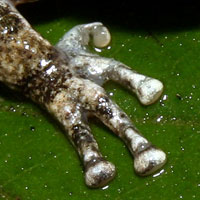 |
 |
|||||||||||||||
| California Treefrog (or Chorus Frog) Pseudacris cadaverina |
Enlarged toe tips | No stripe through eye | |||||||||||||||
| True Frogs |
|||||||||||||||||
| The following frogs are Ranid or "true" frogs, which are characterized by a relatively slim waist, long legs, smooth skin, webbed feet, and folds along the sides of the body. These frogs are excellent jumpers. Here is a chart of the features of Ranid frogs found in California that can help you distinguish between similar species. |
|||||||||||||||||
| Red-legged and Yellow-legged Frogs |
|||||||||||||||||
| These frogs are similar in appearance and sometimes occur in the same area, so they are treated together here. These frogs may be difficult to distinguish from other frogs occurring in the same area. Red- and Yellow-legged Frogs will also sometimes be difficult to tell apart. You may confuse small Red-legged or Yellow Legged Frogs with Pacific Treefrogs. Look at the toe tips to see if the frog is a treefrog. Bullfrogs are similar, especially juveniles, but they have a fold around the eardrum and tend to be green, often with mottling, while red and yellow legged frogs are not bright green. Tailed Frogs will have vertical pupils, a dark mask through the eye and no fold along the sides. The Northern Red-legged Frog is very similar in appearance to the Cascades Frog, but they should not occur in the same areas in California. The Cascades Frog will have yellow underneath, while an adult Red-legged Frog will have red. (Be careful, juvenile Red-legged frogs may appear yellowish underneath.) Foothill Yellow-legged Frogs tend to prefer to jump in water and sit on the bottom, relying on their cryptic pattern to hide them, while these other frogs tend to either hop away quickly, or dive into the water and swim away quickly. Click here for range maps and more help in identifying Red-legged and Yellow-legged Frogs in California. |
|||||||||||||||||
 |
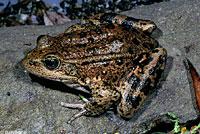 |
||||||||||||||||
| Northern Red-legged Frog Rana aurora |
California Red-legged Frog Rana draytonii |
||||||||||||||||
 |
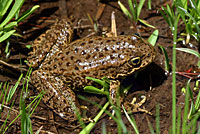 |
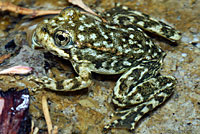 |
|||||||||||||||
| Foothill Yellow-legged Frog Rana boylii |
Sierra Nevada Yellow-legged Frog Rana sierrae |
Southern Mountain Yellow-legged Frog Rana muscosa |
|||||||||||||||
| Cascades Frog |
|||||||||||||||||
While common in the mountains of Oregon and Washington, in California the Cascade Frog is found only in the far north at higher elevations in the mountains. It has disappeared from many of the areas it once inhabited in California. It might be confused for a Red-legged Frog, but these species should not occur together in the same part of California. The Cascades Frog will have a light or yellowish color on the underside of the legs, while adult Red-legged Frogs will have red coloring. Click here for more pictures and information about the Cascades Frog. |
|||||||||||||||||
 |
 |
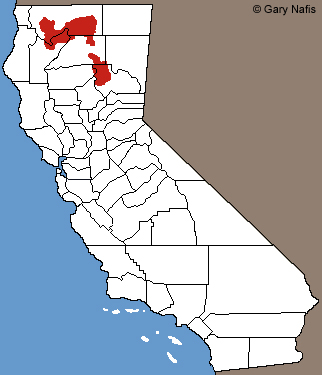 |
|||||||||||||||
| Cascades Frog Rana cascadae |
Historic Range - in red | ||||||||||||||||
| Leopard Frogs |
|||||||||||||||||
Leopard Frogs are moderately-sized frogs, 3.5 - 4.5 inches long, with large dark spots on a green or brown back, and very distinct folds along the sides of the body. They are difficult to identify by sight alone, so knowing where a frog came from in California is the best way to identify it. The Northern Leopard Frog has been found in isolated areas in the northeast, the central valley, around Lake Tahoe, and the northern Owens Valley region. They have been commonly used as laboratory animals, so they have occasionally escaped and formed small populations, especially in agricultural areas in the Central Valley. So far, the Southern Leopard Frog has only been found at one location in Western Riverside Co. in the Prado flood control basin. The Lowland Leopard Frog once occurred in the Sonoran Desert east of the Peninsular Ranges, and along the Colorado River, but it appears to have disappeared from California. If it still occurs in the state, it will be found in areas where the Rio Grande Leopard Frog also occurs, and these two frogs will be very difficult to tell apart. The Rio Grande Leopard Frog is found in the Imperial Valley and along the southern part of the Colorado River and north of the Salton Sea in the southern part of the Coachella Valley. Click here for range maps and more help in identifying Leopard Frogs inhabiting California. |
|||||||||||||||||
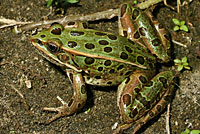 |
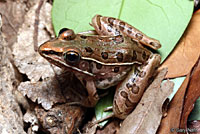 |
 |
|||||||||||||||
| Northern Leopard Frog Lithobates pipiens |
Southern Leopard Frog Lithobates sphenocephala |
Lowland Leopard Frog Lithobates yavapaiensis |
|||||||||||||||
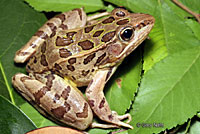 |
|||||||||||||||||
| Rio Grande Leopard Frog Lithobates berlandieri |
|||||||||||||||||
| Oregon Spotted Frog |
|||||||||||||||||
| The Oregon Spotted Frog is reddish brown with dark spots on the back and red underneath. The eyes are slightly turned up. This frog is possibly extirpated from California, though it might still occur in the extreme northeast part of the state in the Warner Mountains. Unless you are in that area, (or in Oregon or parts of Washington) then your frog is not an Oregon Spotted Frog. (The Columbia Spotted Frog is more commonly found in the west, east of the Cascade Mountains, but not in California. (The spotted frogs on the eastern side of the Warner Mountain have been identified as Columbia Spotted Frogs, but they appear to be extirpated also.) Click here for more pictures and information about Oregon Spotted Frogs. |
|||||||||||||||||
 |
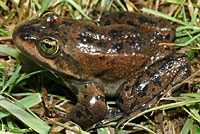 |
 |
|||||||||||||||
| Oregon Spotted Frog Rana pretiosa |
Historic Range - in red | ||||||||||||||||
| American Bullfrog |
|||||||||||||||||
American Bullfrogs are widespread and very common. If you see a large brown and green frog (up to 8 inches long) in a permanent body of water just about anywhere in California except very high elevations, it is most likely an American Bullfrog. American Bullfrogs do not have a dorsolateral fold, but they do have a fold surrounding the eardrum. Juveniles are much smaller, and are more common. One good way to identify juveniles is by the loud chirping sound they make as they jump from the shore into the water when you approach. Other frogs that occur with the American Bullfrog do not make this sound. This frog is rarely seen away from water, but you can sometimes find them on roads at night. Male Bullfrogs often call during the day, which may help you identify the frog. Click here for more pictures and information about American Bullfrogs. |
|||||||||||||||||
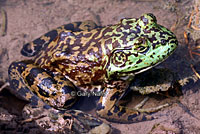 |
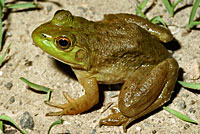 |
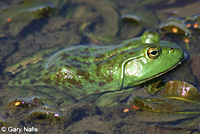 |
|||||||||||||||
| American Bullfrog Lithobates catesbeianus |
|||||||||||||||||
Other Frogs and Toads |
|||||||||||||||||
| Coastal Tailed Frog |
|||||||||||||||||
| The Coastal Tailed Frog is only found in cold fast-flowing rocky creeks and streams in well-shaded humid forests along the north coast and northwest mountains. It is fairly small, 1 - 2 inches long. It is typically found hopping around on rocky creek banks, or hiding under rocks or logs near streams. Red-legged Frogs, Yellow-legged Frogs, and Pacific Treefrogs are found in the same areas, but you can identify this frog by its vertical pupil, a dark stripe through the eye, and the tail-like organ of male frogs which protrudes from the rear of the frog. Adult Tailed Frogs are also larger than adult Pacific Treefrogs. Juveniles can be hard to differentiate from Red- and Yellow-legged Frog juveniles. Click here for more pictures and information about Coastal Tailed Frogs. |
|||||||||||||||||
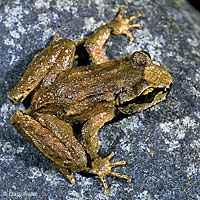 |
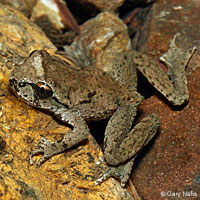 |
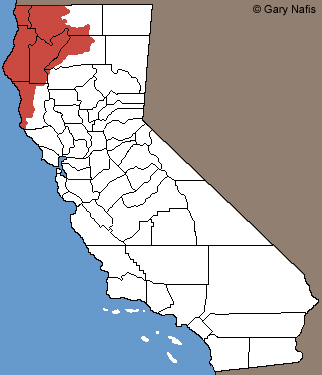 |
|||||||||||||||
| Coastal Tailed Frog Ascaphus truei |
Range - in red | ||||||||||||||||
| African Clawed Frog |
|||||||||||||||||
The non-California-native African Clawed Frog spends almost all of its time in water hiding under leaves or other vegetation or loose soil, making it difficult to see unless you look at night with a flashlight. They have been introduced mostly into permanent water sources in coastal Southern California, but they have also been found in ponds in the Mojave Desert, the Imperial Valley and Colorado River area, and at a pond in Golden Gate Park in San Francisco. Click on the link below for more pictures and information about African Clawed Frogs. |
|||||||||||||||||
© Todd Battey 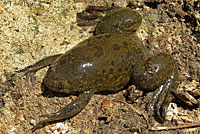 |
© Dick Bartlett 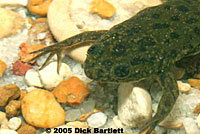 |
 |
|||||||||||||||
| African Clawed Frog Xenopus laevis |
Introduced Range - in red | ||||||||||||||||
| Spadefoots |
|||||||||||||||||
Spadefoots resemble small toads with their rounded bodies and somewhat bumpy skin. You can tell them apart from true toads by their vertical, cat-like pupils, smoother skin, and lack of enlarged parotoid glands behind the eyes. They also have a hardened black digging spade on the back feet. (Some toads have a hardened growth on the back feet for digging, but it is usually not black.) Spadefoots are typically found in dry areas only during times of heavy rain when the ground is wet and temporary pools form. However, they may be out and about longer in agricultural areas where there is moisture from irrigation. There are three types of spadefoots in California which are similar in appearance, but, fortunately, they do not occur together in an area, so looking at the range maps will be the best way to identify them. Go here if you want to identify a Spadefoot in California. |
|||||||||||||||||
 |
 |
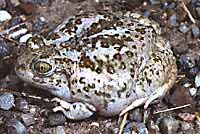 |
|||||||||||||||
| Vertical Pupils | Black Spade on Hind Feet | Western Spadefoot Spea hammondii |
|||||||||||||||
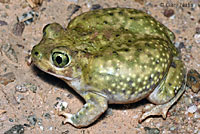 |
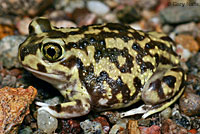 |
 |
|||||||||||||||
| Male Couch's Spadefoot Scaphiopus couchii |
Female Couch's Spadefoot Scaphiopus couchii |
Great Basin Spadefoot Spea intermontana |
|||||||||||||||
Return to the Top
© 2000 -

